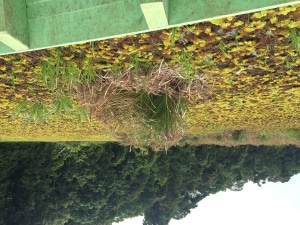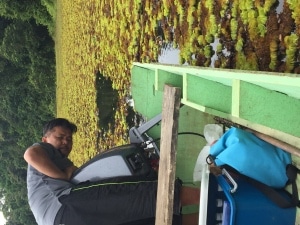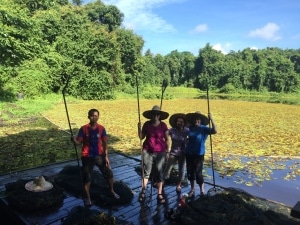Salvinia molesta is an aggressive aquatic fern invading almost all of the oxbow lakes along the Kinabatagan River floodplain. This fern is so invasive that it takes over entire lakes within weeks of arriving! We experienced this firsthand at Tungog Lake. A flood in 2001 brought Salvinia into the lake. I could not fully comprehend the scope of this issue until I was in the middle of it all on a boat. Our local guide Edris Arpah took a few of us out into the take to take measurements for dissolved oxygen and other parameters. The Salvinia was so thick that we could not even take the boat to the other end of the lake. There were grasses, plants, and even trees growing on the Salvinia. To move through the it, Edris often had to stop and lift the motor and pull the Salvinia off. When I compared dissolved oxygen levels of Tungog Lake to a slightly different Salvinia -free Kaboi Lake, I was stunned! Kaboi Lake had an average DO of about 8 mg/L while Tungog Lake was about 2 mg/L. Just for your reference, most fish species need 4-15 mg/L of DO. So the Salvinia has to go!

Why does Tungog Lake have such depleted levels of DO? Salvinia form thick mats and as more and more grow on top of each other, dead Salvinia sink to the bottom. At the bottom, bacteria decompose all organic matter and because so much organic matter is sinking down due to the Salvinia, oxygen gets severely depleted…to the point where aquatic organisms might not survive.

This is a very concerning issue because Tungog Lake is one of the center attractions of the Tungog Rainforest Eco-camp. Luckily the director of Kopel, Martin Vogel, is all over this issue. In earlier years, Kopel was able to remove Salvinia mechanically due to funding. Sadly, when the funds ran out, Salvinia grew out of control. Now he is looking into bio-control. I know what you’re thinking, introducing another exotic species into the mix…is that really a good idea? In fact, it is. There has been overwhelming success with introducing the Salvinia weevil in Australia and other countries to control Salvinia density. Once launched and if successful, this will increase eco-tourism which will bring in funds for conservation and restoration.

By Arti Lal
